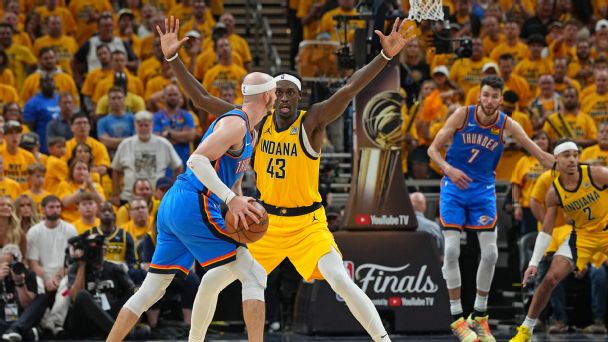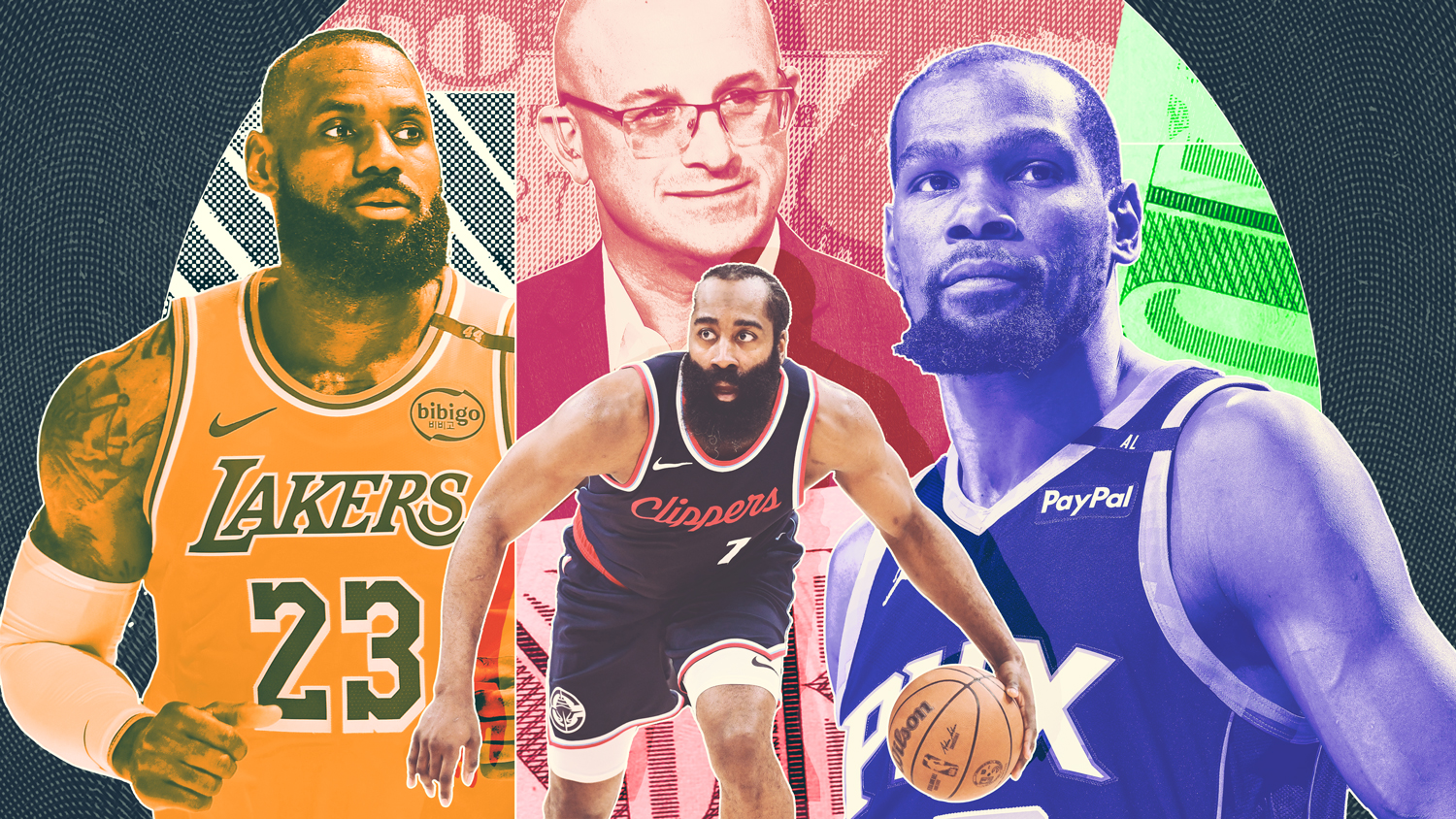

TRAILING BY A point late in Game 4 of the NBA Finals, the Oklahoma City Thunder‘s season seemingly hanging in the balance, Shai Gilgeous-Alexander brought the ball up the left side of the Gainbridge Fieldhouse floor.
The MVP had the matchup he wanted and went to work one-on-one against Indiana Pacers wing Aaron Nesmith.
Gilgeous-Alexander darted left, taking two hard dribbles away from the rest of the Indiana defense. Nesmith stayed on his right hip for a couple of strides with the help of a hand check before Gilgeous-Alexander popped the defender with a sudden, strong forearm across the “INDIANA” on his chest, a forceful enough blow to put the 6-foot-5, 215-pound guard on the seat of his pants in the paint.
As Pacers fans protested what they believed should have been an offensive foul, Gilgeous-Alexander gathered his balance while stepping back for a baseline 15-footer as Andrew Nembhard scrambled over for a too-late attempt to contest the shot.
The ball splashed through the net, giving Oklahoma City the lead for good with 2:23 remaining in its series-tying comeback win. The most important moment of Gilgeous-Alexander’s career was a midrange jumper, a shot non grata for most in the modern NBA that has been mastered by the league’s best scorer.
It surely brought a smile to Sam Cassell, the longtime NBA assistant coach whose playing career is best remembered for a since-outlawed celebratory dance, winning three championship rings and a mastery of the midrange.
“I gave Shai everything I had, everything in my bag,” Cassell told ESPN. “He’s just a bigger version of me — bigger and faster.”
Gilgeous-Alexander spent only one season under Cassell’s wing, but the seeds of the NBA scoring champion’s offensive success were planted during their daily workouts in his rookie year with the LA Clippers. In a league that continues to trend more and more beyond the 3-point arc, Gilgeous-Alexander has an old-school game in which the midrange is the meat of his shot diet.
“I know that’s the shot that in today’s game that they’re giving up. They’re giving you the 15-foot pull-up shot,” Cassell told ESPN. “So I just told him from day one, if this is the shot they’re giving, let’s be exceptional at this shot. Let’s be the only player in the league that can be exceptional at this shot since they’re giving it to you.
“The analytic guys say it’s a bad shot, but it ain’t a bad shot for him. We worked on the same stuff for days. If anything go wrong, this is your bread and butter.”
Defenses aren’t willing to give Gilgeous-Alexander the midrange shot anymore, but he’s still taking and making them at clips that make him a rarity in any era, especially the modern-day NBA.
In fact, Gilgeous-Alexander’s midrange attempts and efficiency have only increased over the past three seasons as he has morphed into an MVP and one of the greatest scorers in league history.
Gilgeous-Alexander led the league with 32.7 points per game on 51.9% shooting this season. It was the third straight season he averaged at least 30 points on better than 50% shooting, putting him in an exclusive club that includes two-time MVP Giannis Antetokounmpo and Hall of Famers Wilt Chamberlain, Adrian Dantley and Michael Jordan.
According to GeniusIQ shot data, Gilgeous-Alexander ranked second behind only Sacramento’s DeMar DeRozan in 2-point jump shots made (261) and attempted (495) this season. Gilgeous-Alexander’s 52.7% shooting on those shots ranked second behind only Phoenix’s Kevin Durant among players who attempted at least 150 2-point jumpers.
Gilgeous-Alexander joined Durant and Chris Paul, a pair of future first-ballot Hall of Famers, as the only players with at least 250 made 2-point jumpers on 50% shooting or better in multiple seasons since player tracking began in 2013-14.
“As my game’s been molded and as I came into my own, I’ve tried to stick with what works and what’s comfortable to me,” Gilgeous-Alexander told ESPN. “That’s one of those things that just has become very comfortable. Then I’ve figured out how to find certain spots in certain situations, and now I just play with it. But it all started with building the comfortability, and [Cassell] had a big part in that for sure.”
EARLY IN THE first quarter of Game 2, Thunder guard Cason Wallace came up to the half-court logo to set a screen, forcing Tyrese Haliburton to switch onto Gilgeous-Alexander. The MVP quickly went to work, taking one hard right-handed dribble to make sure Andrew Nembhard had no chance to recover and then crossing over to glide down the middle of the floor.
Haliburton managed to stay in front of Gilgeous-Alexander and seemingly had decent position — for a brief moment, at least. Then Gilgeous-Alexander gave him a subtle, strong bump with his right shoulder as he picked up the dribble. Just like that, he had an easy, open pull-up at the dotted line.
“People don’t realize how strong he is,” Thunder wing Alex Caruso told ESPN. “When he gets to 10 foot and he hits you with a big shoulder and spins off of you, it takes a toll on you. It’s harder than people realize. Without being illegal, which is the key. He’s never going 100 miles an hour. He always is kind of like just in front of you or allowing you to cut him off so he can counter. He’s a very smart player. You’re not at the level he is without being an intellectual player.
“You mix that with the physical stuff, and it’s MVP stuff.”
Game 2 was an MVP performance — 34 points on 11-of-21 shooting and eight assists — and a midrange masterpiece by Gilgeous-Alexander. He shot 6-of-9 on 2-point jumpers in the game, 4-of-8 on floaters and layups and 1-of-4 on 3s.
He swished midrange shots from all over the floor over several different defenders. Every one of them was off the dribble, as was the case on 248 of his 261 made 2-point jumpers during the regular season.
He made Bennedict Mathurin dance as he waltzed from the right wing to the left elbow, dribbling the ball with his left hand the whole time. When Mathurin bit on a fake crossover, Gilgeous-Alexander stepped back to an 18-footer on one of his sweet spots. He has several.
“You have to have multiple spots,” Gilgeous-Alexander said. “If you have spots going both ways, they have to pick one way and you go the other way and vice versa. The more spots, the more shots, the more variety you have, the harder it is to guard.”
Gilgeous-Alexander shot over Nesmith a half-step away from that same spot, creating space by dribbling behind his back before stepping back. He swished one just inside the top of the key over Myles Turner, who played back in fear of Gilgeous-Alexander slithering by him into the lane. He hit a tightly contested turnaround jumper over Mathurin on the left block — a classic case of good defense, better offense. And he gave Ben Sheppard a shoulder bump to give himself plenty of room for a fadeaway near the right elbow.
“There’s just a variety to his game,” Thunder coach Mark Daigneault said. “He can get to there a lot of different ways. He’ll post. He’ll play the pick-and-roll game. He can iso. He finds it in the flow. I think the diversity of that helps.
“Then the diversity of his shot profile. He’ll pass, get to the rim, he’ll shoot 3s as well. It’s not like he’s just a fastball pitcher. He’s got a lot of different things that he can go to that keeps teams off balance.”
2:32
Thunder dig deep in Game 4 to tie series
Shai Gilgeous-Alexander’s 14th 30-point game this postseason drives the Thunder to a hard-fought Game 4 victory to tie the series at two apiece.
THERE ARE DISTINCT shades of Lakers legend Kobe Bryant in Gilgeous-Alexander’s game. It’s intentional. Like many in his generation, Gilgeous-Alexander considered Bryant his favorite player and studied the intricacies of his game.
“A ton, a ton — more than anyone ever, for sure,” Gilgeous-Alexander said. “The way he attacked the game is very impressive to me, and I just think he’s one of the most skilled players ever. To have the combination of being one of the most skilled players ever and to be able to attack the game the way he did is why he had such a prolific scoring career. It’s no coincidence. The closer I can get to that level, the better off I’ll be.”
It’s the blend of size, strength, savvy and skill that makes Gilgeous-Alexander so hard to stop.
He’s 6-6½ with a wingspan of 6-11½, giving Gilgeous-Alexander the length to get good looks over defenders. He’s lean, listed at 195 pounds, but possesses wiry strength, as any defender who has felt his shoulder thud into their chest can attest. Gilgeous-Alexander is a “master of angles,” as Caruso put it, who uses an array of pump-fakes, pivots and other tricks to create space or bait defenders into fouling him. And Gilgeous-Alexander has a tight handle that Cassell told him years ago would allow him to control the game by getting anywhere he wanted to go with the ball.
“He’s just deceiving,” Cassell said. “His speed is deceiving. His ability to jump is deceiving. His whole game is deceiving — until he gets up on you. Then you say, man, he is tall. He is stronger than you think he is.”
Nembhard, the primary defender on Gilgeous-Alexander in the Finals, is as prepared to defend the MVP as anybody. They’ve been competing against each other since they were kids growing up in Toronto. Nembhard knows there are occasions that Gilgeous-Alexander will score regardless of the quality of defense.
“He’s physical and he’s shifty, so he’s hard to stay tight with,” Nembhard said. “Then when you do, he bumps you. On top of that, he’s tall, he’s long and he can get those shots over the top of defenders. And he’s practiced that a lot.”
ESPN Research’s Matt Williams contributed to this story.
Source link




